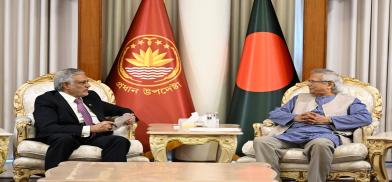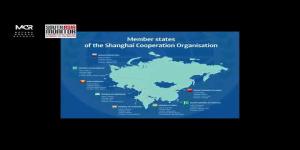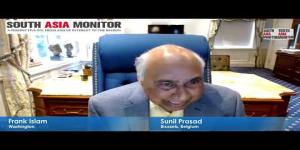Strange Bedfellows: Why Pakistan’s Munir and Bangladesh’s Yunus Are Rekindling Ties
From a realistic perspective, the prospect of a Pakistan-Bangladesh axis does not herald a serious economic or strategic bloc. Instead, it signals the re-emergence of revisionist politics in South Asia. In seeking to rewrite history and align against India, both countries risk ignoring their own domestic crises.

When Pakistan’s Deputy Prime Minister Ishaq Dar landed in Dhaka last week, the symbolism was as important as the substance. On paper, the visit was about strengthening bilateral ties through trade, cultural exchange, education scholarships, and improved connectivity. Six agreements were inked, ranging from visa-free official travel for officials to academic and media cooperation, along with plans for direct flights between Dhaka and Karachi.
A “Pakistan-Bangladesh Knowledge Corridor” was even announced, promising 500 scholarships for Bangladeshi students in Pakistani universities.
Shared anti-Indianism
But the real driver behind this sudden thaw between two historically estranged nations is not commerce or culture. It is a shared anti-Indianism and a quiet project of historical revisionism that seeks to turn the clock back to a pre-1971 world—when Bangladesh was East Pakistan.
The official narrative emphasises trade and investment. Pakistan exported nearly $778 million worth of goods—cotton, cement, chemicals, sugar, and cereals—to Bangladesh last year, while Dhaka’s exports to Pakistan barely crossed $50–70 million.
Even if new initiatives push annual trade past the symbolic $1 billion mark, it will remain negligible compared to Bangladesh’s $12–16 billion annual trade with India.
For both countries, the economic dimension is more about symbolism than substance. Pakistan, ostensibly run by a civilian government but in reality a nation where the shots are called by Field Marshall Asim Munir, desperately needs new markets as it struggles under an external debt burden of $87 billion and faces $23 billion in repayment obligations next year.
Bangladesh, with growth slowing to just 3.97% in financial year 2025, double-digit inflation, and mounting lawlessness, is equally eager to diversify partners. Yet, the structural imbalance — Pakistan supplying raw materials, Bangladesh trading scraps — means little real benefit for Dhaka.
A Political Reset
The real story lies in politics. The Yunus interim government in Dhaka has methodically reset foreign policy away from its traditional reliance on India.
Sheikh Hasina’s years of India-centric diplomacy have been replaced by a deliberate outreach to Pakistan, China, and Turkey, powers that share a more adversarial stance toward New Delhi.
Critics within Bangladesh, especially the opposition Awami League, have called this pivot “Pakistanisation,” accusing the government of erasing the historical memory of the Liberation War.
The charge is not without merit.
Pro-Pakistan groups long suppressed under Hasina have found fresh space under the Yunus administration, while Dhaka courts arms deals and military exchanges with Pakistan and Turkey. The rhetoric of regional cooperation through SAARC revival only serves to mask a more calculated strategy of distancing from India.
For Islamabad, rapprochement with Dhaka serves two purposes. First, it dilutes India’s regional clout by peeling away what was once considered a reliable Indian ally.
Second, it allows Pakistan to reframe the narrative of 1971 — not as a decisive defeat and secession, but as a temporary rupture that can be politically “managed” by rekindling Islamic solidarity and economic ties, by selling its new found friendship with Dhaka’s temporary government as a major diplomatic coup.
The “Knowledge Corridor” scholarships, cultural exchanges, and talk of youth programs are not innocuous soft-power gestures; they are part of a systematic attempt to recast Bangladesh’s younger generation in a narrative divorced from the Liberation War and aligned with a broader Islamic identity.
Both Pakistan and Bangladesh remain deeply fragile states. Pakistan’s GDP growth of 2.7% is barely above population growth, while debt servicing eats up nearly half its federal budget. Bangladesh, despite its larger GDP of $462 billion, faces inflation above 10%, rising communal violence, mob justice, and an atmosphere of lawlessness.
Both economies are on life support from multilaterals like the IMF and ADB. And yet, even in this precarious state, both governments seem more animated by geopolitics than economics.
The glue binding the regimes, in Islamabad and Dhaka, is less about mutual benefit and more about mutual resentment of India’s economic rise, its regional leadership, and its decisive role in 1971.
The other issue is trying to save tarnished images of respective leaders.
On the one hand, Pakistan’s strongman Munir, despite claims of “victory” against India is increasingly facing tough questions on the outcome of the short exchange of missiles and drones on why Indian weapons could penetrate and hit both militant camps and Pakistan Air Force bases.
At the same time Yunus’s image has taken a severe beating on account of the continued chaotic situation where Bangladesh faces mob justice, accusations of silencing voices of dissent besides economic and diplomatic failures.
A reset with Pakistan is a way to win over at least part of the constituency and to come up with a show which distracts public attention from the “jelly state” in which both nations find themselves — where they refuse to totally fail but at the same time remain on the brink of failure.
Turning Clock Back?
From a realistic perspective, the prospect of a Pakistan-Bangladesh axis does not herald a serious economic or strategic bloc. Instead, it signals the re-emergence of revisionist politics in South Asia. In seeking to rewrite history and align against India, both countries risk ignoring their own domestic crises.
For the Yunus regime in Dhaka, aligning with Islamabad means further alienating its largest trading partner and risking the erosion of its founding values.
For the military backed government in Islamabad, the tie-up with Dhaka is yet another attempt to export anti-Indianism as a substitute for real governance or reform and feed its own populace the story that it is able to turn the clock back.
However, the real question is will two failed regimes really grow stronger or be able to give their nations more security by joining hands, or will the combination of their weaknesses drag them down further?
(The author is a senior journalist and strategic analyst who specialises in the political economy. Views expressed are personal.)









Post a Comment